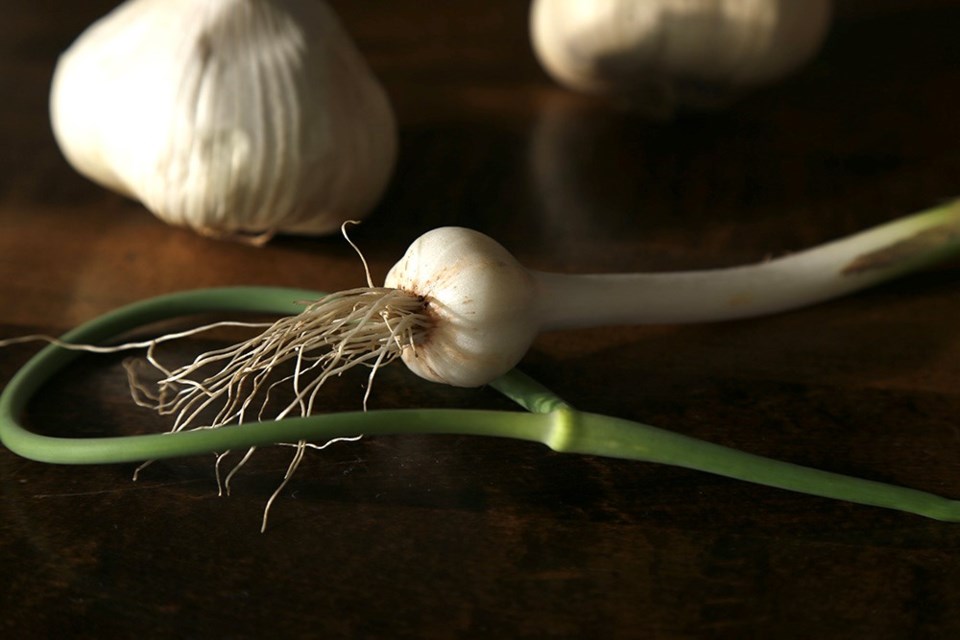I was delighted recently to identify what I believe is wild field garlic (Allium vineale) growing in the understory of our dwarf fruit trees.
The diminutive, fully formed bulbs weigh in at about 10 per cent of the weight of conventional hardneck garlic.
Last February, while renovating a patch of overgrown landscape into raised beds for a friend, I came across small, ordered clumps of delicate, tubular mounding grass. What struck me was its vibrancy and tender suppleness, at a time of year when most plants remained dormant.
Curious, I transplanted the slightly pungent clumps into one-gallon pots, and set them aside under the shade of a nearby oak tree. There they remained for 15 months – slumbering quietly, insulated by fallen leaves.
I ran across them again three months ago, reaching up through the sea of brown detritus like a family of brilliant green sea urchins. I was smitten, and brought the beautiful creatures home.
I transplanted them into one our front garden beds, alongside native wild strawberries and perennial herbs. They did not take at all well to transplanting, so I attempted rescue with a top-dress of vermi-compost and restorative cold teas of soluble mycorrhizal fungi, kelp and sea minerals, administered weekly.
Slowly but surely my garden babies of unknown progeny recovered, and about three weeks ago, several dozen miniature garlic stocks started emerging here and there among the clumps of stringy and decidedly un-garlic-like leaves. Then slender scapes appeared, arching up and turning toward each other, forming little green hearts of gratitude. I was delighted.
Once the scapes had produced one full turn, I pulled out a few whole stalks for examination. After consulting my 1931 edition of Wild Plants of Canada, and several more current foraging guides, I am quite sure that field garlic, a.k.a. stag’s garlic, is the correct identification.
I was fascinated to also learn that every wild plant that smells like onions or garlic is edible, and that field garlic provides much needed nourishment and immune system fortification during the cold winter months, when little else is growing. Look for field garlic under deciduous trees that let precious, life-giving sunlight stream down between bare branches.
Field garlic is delicious. I have decided to use the tiny cloves in jars of pickled cucumbers and baby carrots. Some I will confit by submerging in olive oil, and cooking slowly over low heat until golden brown. Some I will leave in the ground to propagate naturally, and I may save some seed to plant elsewhere on our property.
Aromatic garlic is one vegetable that I couldn’t live without, and is one of the easiest to grow in planters, pots and beds. I plant hardneck garlic cloves in early March, in individual pots, then transplant them carefully into large planting holes when the leaves are about eight inches high. It’s a non-traditional approach perhaps, but it works for us in this cold and wet climate, and I like the real-time flexibility of choosing just where to plant along with other seasonal starts.
Cured garlic stores well in a cool dark environment, but it is best enjoyed when fresh. Sliced fresh garlic can be dehydrated and stored in a jar, or powdered. I keep an old coffee grinder just for blending small quantities of hard spices, as the small bowl and strong motors make quick and easy work of it.
The scapes too are delicious fresh, pickled or fermented, and can be used in place of clove garlic to make pesto, hummus, salsa, and thousands of other recipes.
Think of garlic as one of nature’s finest and most delicious natural medicines. Research shows that garlic helps build immunity and protection from common colds, contains powerful antioxidants to help prevent cancer and Alzheimer’s disease, and helps regulate blood pressure and cholesterol levels. Garlic is rich in vitamins C and B6, and manganese, and is thought to improve bone health and even help protect against heavy metal poisoning.
To enjoy garlic’s many health and culinary benefits, grow garlic organically or purchase it from an organic grower. Purchase natural fertilizers and fungal inoculants from the Organic Gardener’s Pantry, Terra Flora Organics, and better garden centres.
Laura Marie Neubert is a West Vancouver-based urban permaculture designer. Follow her on Instagram @upfrontandbeautiful, learn more about permaculture by visiting her Upfront & Beautiful website or email your questions to her here.
For a taste of permaculture, click on the YouTube link below:
(Video - Courtesy of West Vancouver Memorial Library)



